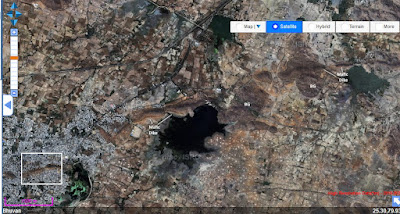A friend recently returned from a trip to Patagonia, Argentina. I mentioned to her that Charles Darwin had spent some time exploring the Patagonian coastline and had made some interesting observations about the local fauna and the native people.
Being a bit vague on the details I dug into one of the most reliable source on Darwin's life and work, the Darwin Online archive. I accessed his Beagle Diary, scrolling down to the time the Beagle docked at Port Desire on December 8, 1833. Below is his entry from December 24, 1833:
24th Took a long walk on the North side: after ascending some rocks there is a great level plain, which extends in every direction but is divided by vallies. — I thought I had seen some desart looking country near B. Blanca; but the land in this neighbourhead so far exceeds it in sterility, that this alone deserves the name of a desart. — The plain is composed of gravel with very little vegetation & not a drop of water. In the vallies there is some little, but it is very brackish. — It is remarkable that on the surface of this plain there are shells of the same sort which now exist. — & the muscles even with their usual blue colour. — It is therefore certain, that within no great number of centuries all this country has been beneath the sea. —1 Wretched looking as the country is, it supports very many Guanacoes. — By great good luck I shot one; it weighed without its entrails &c 170 pounds: so that we shall have fresh meat for all hands on Christmas day.
John van Wyhe, ed. 2002-. The Complete Work of Charles Darwin Online- Beagle Diary.
As always his keen geology eye had spotted shells which were similar to living shelly creatures, leading him to the conclusion that this region must have been under the sea in the past. All along the South American coastline he noticed oyster and shell beds a meter or two above the current sea level. He concluded that there must have been vertical movement of the crust.
He was a good hunter too. Apart from the Guanacoe, one of this shipmates shot a rhea. The crew ate that too. Darwin realized only too late that he wanted the entire bird to compare its form to rhea elsewhere in S.America. Eating valuable zoological samples became a common occurrence all through the voyage of the Beagle.
The Beagle then sailed south to Port Julian. On his walks there Darwin came across bits of spine and hind legs of a largish creature, later identified as a Megatherium or ground sloth. That led him to muse about what could have killed off this variety, as nothing like it existed today. The sedimentary layers entombing the fossil did not indicate any kind of flood. How could an entire species die off? Taking inspiration from cuttings of apple trees which were clearly part of the parent, Darwin wondered if all individuals of animal species too shared some life force. If so, could a common disturbance or event kill all of them off?
In February 1834 the Beagle sailed into the Straits of Magellan and Tierra del Fuego. He immediately formed a low opinion of the natives whom he though of as uncivilized savages, living naked and unkempt in an utterly desolate landscape:
Their country is a broken mass of wild rocks, lofty hills & useless forests, & these are viewed through mists & endless storms. In search of food they move from spot to spot, & so steep is the coast, this must be done in wretched canoes. — They cannot know the feeling of having a home — & still less that of domestic affection; without, indeed, that of a master to an abject laborious slave can be called so. — How little can the higher powers of the mind come into play: what is there for imagination to paint, for reason to compare, for judgement to decide upon. — to knock a limpet from the rock does not even require cunning, that lowest power of the mind. Their skill, like the instinct of animals is not improved by experience; the canoe, their most ingenious work, poor as it may be, we know has remained the same for the last 300 years. Although essentially the same creature, how little must the mind of one of these beings resemble that of an educated man. What a scale of improvement is comprehended between the faculties of a Fuegian savage & a Sir Isaac Newton — Whence have these people come?
John van Wyhe, ed. 2002-. The Complete Work of Charles Darwin Online- Beagle Diary.
Darwin compared the Fuegian natives with natives he had met further north along the Patagonian coast. Those tribes appeared better dressed, with some European contact spoke a smattering of English and Spanish, and had learned to eat with a fork and knife.
Could the savage Fuegian change their life habits too? Darwin was doubtful. He thought that hundreds of years of living in this habitat had formed an instinct that could not change, a view reinforced when Jemmy a Fuegian native who had lived with Europeans was seen to have gone back to his native state. Perhaps, Darwin thought, differences between human populations were more deep than realized.
Much more of South America remained to be explored. At this time his interest lay primarily in geology, but questions about species extinction and fixity, and the nature of human differences in life habits and intellect, lingered on in his mind.
If you would like to read more about Darwin I will recommend Adrian Desmond and James Moore's fine biography, Darwin: The Life Of A Tormented Evolutionist.








































